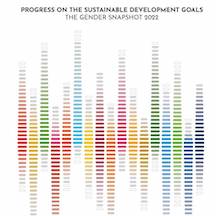United Nations Study Presents Stark Statistics on Gender Inequality Worldwide
Posted on Sep 21, 2022 | Comments 0
 The United Nations Department of Economic and Social Affairs has issued a new report that finds that “COVID-19 and the backlash against women’s sexual and reproductive health and rights are further diminishing the outlook for gender equality. Violence against women remains high; global health, climate, and humanitarian crises have further increased risks of violence, especially for the most vulnerable women and girls; and women feel more unsafe than they did before the pandemic. Women’s representation in positions of power and decision-making remains below parity.
The United Nations Department of Economic and Social Affairs has issued a new report that finds that “COVID-19 and the backlash against women’s sexual and reproductive health and rights are further diminishing the outlook for gender equality. Violence against women remains high; global health, climate, and humanitarian crises have further increased risks of violence, especially for the most vulnerable women and girls; and women feel more unsafe than they did before the pandemic. Women’s representation in positions of power and decision-making remains below parity.
The report provides a list of key indicators on gender inequality including:
- 380 million women and girls live in conditions of extreme poverty, living on less than $1.90 a day.
- The lack of clean water results in the deaths of 800,000 women and girls each year.
- One third of women worldwide experienced moderate or extreme food insecurity in 2021.
- Ten percent of women aged 15-49 were subjected to sexual and/or physical violence by an intimate partner in the previous year.
- School and daycare closures in 2020 due to the pandemic created an additional 512 billion hours of unpaid childcare for women.
- Women are one third of managers and supervisers. At the current rate of progress, it will take 140 years to reach gender parity.
- Women holds only 20 percent of jobs in information and communication technolgy.
- Women make up 16.5 percent of the people who hold patents.
- 44 million women and girls have been forced to leave their homes due to climate change or war.
- Women make up 16 percent of police officers worldwide.
The full report, Progress on the Sustainable Development Goals: The Gender Snapshot 2022, may be downloaded here.
Filed Under: Gender Gap • Research/Study








